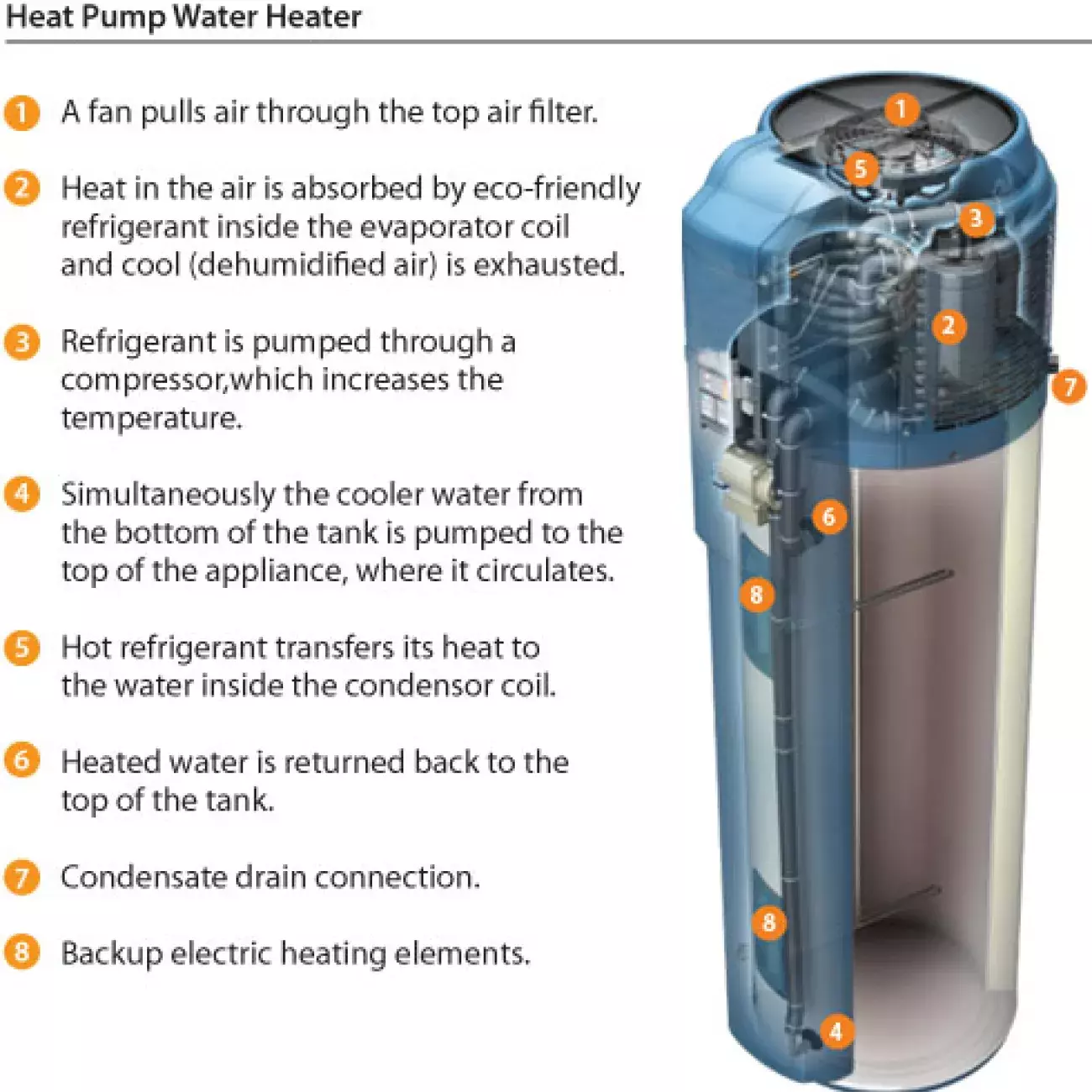Heat Pump Water Heaters
A heat pump can not only be used to heat and cool your home, but also be used to heat water. To work, an air-source heat pump water heater pulls heat from the surrounding air and dumps it—at a higher temperature—into a tank to heat water.

A heat pump water heater looks like a tall cylinder with a small chamber on top and a larger one on the bottom. In the top chamber are a fan, a cylindrical compressor, and an evaporator that runs along the inside of the chamber. Jutting out from the exterior of the bottom chamber is a temperature and pressure relief valve. This valve has a tube called a hot water outlet attached to the top. Below the valve is the upper thermostat, a small square outside the cylinder that is attached to a curved tube inside the heater. Resistance elements run from the upper thermostat to the similarly shaped lower thermostat. Below the lower thermostat is a drain valve with a cold water inlet attached to the top. Inside the cylinder is an anode, a series of thin tubes running through the bottom chamber to a coiled tube called a condenser. Insulation runs along the inside of the cylinder.
Selecting a Heat Pump Water Heater
Heat pump water heater systems typically have higher initial costs than conventional storage water heaters. However, they have lower operating costs, which can offset their higher purchase and installation prices. You can purchase a heat pump water heating system with a built-in water storage tank and back-up resistance heating elements. You can also retrofit a heat pump to work with an existing conventional storage water heater. You can also install an air-source heat pump system that combines heating, cooling, and water heating. These combination systems pull their heat indoors from the outdoor air in the winter and from the indoor air in the summer. Because they remove heat from the air, any type of air-source heat pump system works more efficiently in a warm climate.
Before buying a heat pump water heating system, you also need to consider the following:
- Size and first hour rating.
- Fuel type and availability
- Energy efficiency (energy factor)
- Overall costs
Installation Considerations
Proper installation and maintenance of your heat pump water heating system can optimize its energy efficiency. Proper installation depends on many factors. such as fuel type, climate, local building code requirements and safety issues. Therefore, it's best to have a qualified heating contractor install your heat pump. Heat pump water heaters require installation in locations that remain in the 40º–90ºF (4.4º–32.2ºC) range year-round and provide at least 1,000 cubic feet (28.3 cubic meters) of air space around the water heater. Cool exhaust air can be distributed to the room or outdoors. They should be installed in a space with excess heat, such as a furnace room because they will not operate efficiently in a cold space. They tend to cool the space where they are located.
Geothermal Heat Pumps and Water Heating
Homeowners primarily install geothermal heat pumps — which draw heat from the ground during the winter and from the indoor air during the summer — for heating and cooling their homes. For water heating, you can add a desuperheater to a geothermal heat pump system. A desuperheater is a small, auxiliary heat exchanger that uses superheated gases from the heat pump's compressor to heat water. This hot water then circulates through a pipe to the home's storage water heater tank.
Desuperheaters are also available for demand (tankless or instantaneous) water heaters. In the summer, the desuperheater uses the excess heat that would otherwise be expelled to the ground. Therefore, when the geothermal heat pump runs frequently during the summer, it can heat all of your water. During the fall, winter, and spring—when the desuperheater isn't producing as much excess heat—you'll need to rely more on your storage or demand water heater to heat the water. Some manufacturers also offer triple-function geothermal heat pump systems, which provide heating, cooling and hot water. They use a separate heat exchanger to meet all of a household's hot water needs.